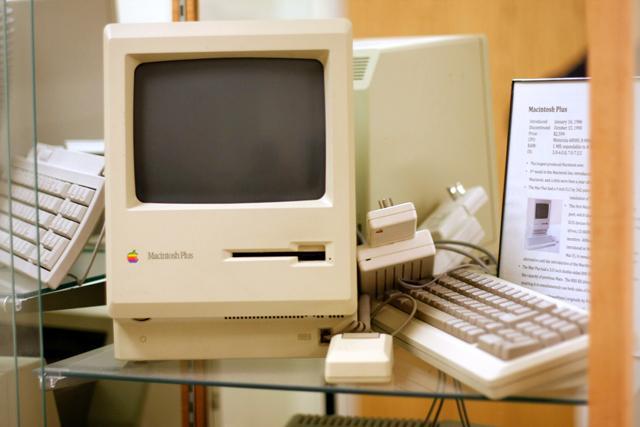Wayne Clark has seen the computing world evolve since the 1970s , but in his pocket he carries a small piece of technology with capabilities that outclass state of the art technology from the computing boom.
“This [smartphone] is more powerful than anything in this entire case.”
Not a statement on his smartphone in particular, but a statement of the development of computing, a field in which Clark is an industry veteran.
Since 2007, displays in Engineering Building II on Centennial Campus have housed a variety of historical computers. Ken Tate, director of development and external relations for the CSC department, has overseen the display.
“We get a lot of interesting and positive comments from people when they come into the building for speaker series, special events and open houses,” Tate said. “It’s interesting to see the older generation talking to their children about some of the things they see, like the ‘portable’ laptop or ‘luggable’ computer. It looks like a sewing machine box.”
For Tate, the display allows students to witness the rise and adaptation of technology, showing how pocket-sized smartphones share their rise from clunkier previous innovations.
“I think a lot of today’s generation just can’t get their heads around just how big some of the components are compared to things that are now so small and portable,” Tate said.
According to Tate, the displays began around 2007, when he was approached by Steven Jones, an alum from the class of ’91, about displaying some computers from his personal collection.
“We didn’t set out to make a museum,” Tate said. “[Jones] approached us saying that he had quite a collection of computer memorabilia, some old units. He offered to donate quite a bit of that to us.”
Jones did not respond to attempts to comment. On his blog, [ www.stevenrjones.com ] he referred to his donation as his “MEGA” (Mr. Early Gadget Adaptor) Collection.
“It is likely that many of you have fond memories associated with the Apple IIe or the Commodore 64,” Jones said on his blog. “These all have some unique significance in the computer historical timeline.”
The computer science department purchased a display case to display the donation, according to Tate, and shortly thereafter another donation was made.
“[Wayne Clark] said ‘I have some stuff you guys might be interested in sitting in my attic, if I pulled it all together would you be interested?'” Tate said,”We said of course.”
Clark, a seasoned innovator of the computer industry and member of the Hunt Library Strategic Advisory Board, donated several pieces to the exhibit, some of which date back to the 1970s .
Tate said the displays are frequently viewed not only by students, but also by visitors for other events such as the College of Engineering open house, the Fidelity Investments “Leadership in Technology” Executive Speakers Series and the NC Science Olympiad. Tate said the speaker series brings in a “standing room only crowd of anywhere from 160 to 200 people,” consisting of both students and members of the local community.
Tate said he expects the collection will continue to grow.
“We frequently get offers of ‘would you be interested in x, y and z?’ There are a few pieces we have that we don’t have the physical space to put in a case right now,” Tate said.
One such piece is an IBM 5100 Portable Computer, donated by Tom Kennedy. The 50-pound machine was state-of-the-art in 1976 and was purchased by Kennedy for over $10,000 to learn the APL programming language. Kennedy has been a teacher’s assistant in CSC 116, Intro to Java Programming, for four years.
“It [the IBM 1500] cost as much as a Cadillac and took me years to pay it off,” Kennedy said. “Eventually, I became good at computer languages, but I became a lot better at handling my money and avoiding temptations.”
According to Tate, a recent donation during winter break by alum, Bobby R. Johnson Jr ., and his wife Donna, will fund the purchase of a new case before the end of the year.








